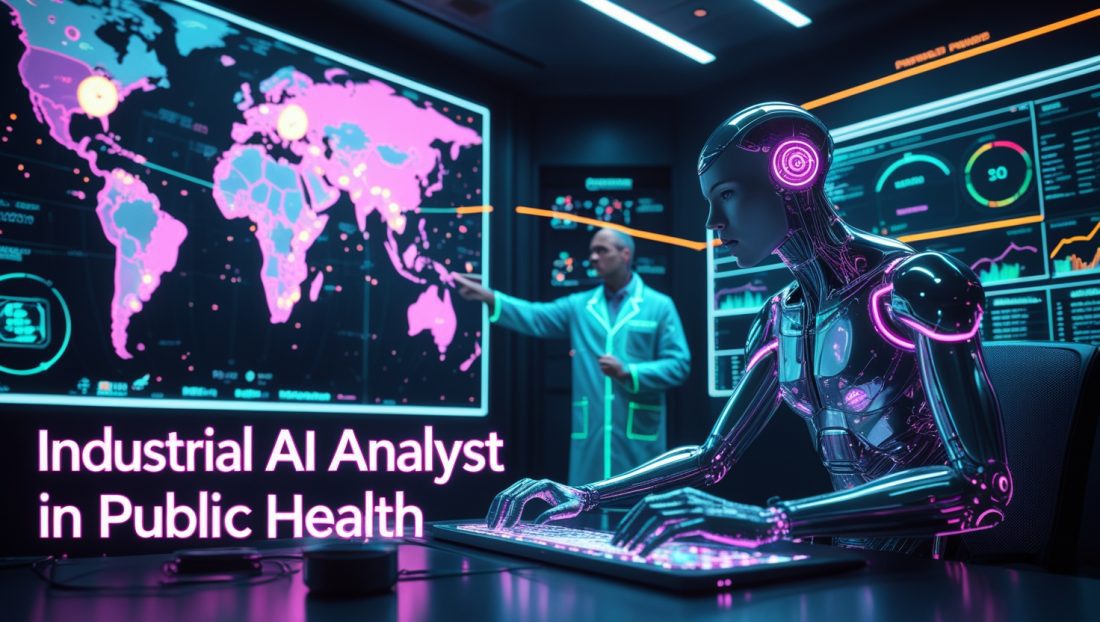Updated 2025
Imagine an Industrial AI Analyst in Public Health working alongside a public health director in 2025, staring at a map flickering with cholera outbreaks across three continents. Traditional data streams—hospital reports, lab confirmations—lag by weeks. But hidden in satellite imagery, social media chatter, and wastewater sensors are real-time clues. The problem? Nobody can connect them.
This isn’t fiction. It’s today’s reality. And it’s why Industrial AI Analysts in Public Health have become the linchpin of global survival.
The Data Deluge Crisis in Public Health
Public health faces an existential data challenge:
- Volume: 30% of the world’s data volume comes from healthcare.
- Fragmentation: Siloed EHRs, genomic databases, and environmental sensors rarely communicate.
- Velocity: Pandemics spread faster than humans can analyze trends (COVID-19 cases doubled every 3 days in 2020).
As Dr. Alicia Chang, Chief Data Officer at the WHO, states:
“We’re drowning in data but starving for insights. Industrial AI Analysts are our translators—they turn noise into action.”
Explore how industries are surviving the data tsunami through AI-powered efficiency.
What Does an Industrial AI Analyst in Public Health Do?
Unlike data scientists focused on model building, Industrial AI Analysts specialize in:
- Operational Integration: Embedding AI in live systems like outbreak detection + hospital bed forecasting.
- Cross-Domain Synthesis: Merging clinical, environmental, and socioeconomic data sources.
- Scalable Governance: Navigating frameworks like the EU AI Act and GDPR.
Real Impact: The Mozambique Cholera Case (2024)
In 2024, cyclone-driven floods triggered a cholera crisis in Mozambique. An analyst team:
- Trained models on satellite flood data and historical outbreaks
- Integrated mobile phone data to predict spread
- Reduced vaccine deployment from 21 days to 72 hours
This is a real-world demonstration of how AI in disaster response saves lives faster than traditional methods can.
The 4 Pillars of Industrial AI Analysis in Public Health
🔍 Pillar 1: Predictive Intelligence Infrastructure
- Disease Forecasting: AI predicts dengue outbreaks 3 months ahead by merging climate and genomic data.
- Resource Optimization: Rush University used AI to cut ICU bed waste by 40%.
“Without Industrial AI Analysts, models stay in journals. They make them work in ERs.”
— Kenji Tanaka, AI Deployment Lead, Johns Hopkins
Compare this to how industrial energy systems optimize performance using predictive AI.
⚖️ Pillar 2: Regulatory Navigation
Health AI is now “high-risk” under the EU’s AI Act, requiring:
- Bias audits
- Performance monitoring
- Human oversight protocols
Analysts keep systems compliant without halting innovation — a lesson drawn from AI ethics battles in 2025.
🛠️ Pillar 3: Technical-to-Clinical Translation
According to Computers in Public Health journal:
| Skill Gap | Prevalence | Analyst Solution |
|---|---|---|
| Clinical Relevance | 67% | Co-design with epidemiologists |
| Model Interpretability | 58% | Explainable AI (XAI) dashboards |
| Legacy System Integration | 72% | API-based middleware |
Analysts bridge the world of tech and medicine where it matters most.
🌐 Pillar 4: Health Equity Engineering
Algorithms trained on biased data often exclude vulnerable groups.
“An AI sepsis predictor failed in rural India because 90% of its data came from urban EU hospitals.”
To avoid failures, analysts build fairness into models, collaborate with community health workers, and drive equity—just like how AI career planning is tackling silent talent crises across sectors.
The Talent Crisis: 200K Jobs Unfilled by 2026
Why?
- Hybrid Skill Scarcity: Few professionals understand both epidemiology and industrial AI.
- Training Gap: Universities still treat public health and AI as separate domains.
- Compliance Complexity: Analysts must understand laws like HIPAA, GDPR, and AI safety protocols.
See how AI hiring bias compounds this problem.
Salary Surge: Proof of Demand
- Health AI Strategists: $98,500+
- AI Healthcare Managers: $93,481 (22% YoY increase)
Your Path to Becoming an Industrial AI Analyst
🎓 Education Requirements
- Core: Python, SQL, TensorFlow/PyTorch
- Extras:
- FHIR/HL7
- GenAI fine-tuning
- AI compliance (e.g. EU AI Act)
💼 Career Launchpads
- Start as a health data analyst ($70,082 avg)
- Upskill through programs like Healthcare AI Deployment Certification
Target Roles:
- Public Health AI Strategist
- Clinical Ops Analyst
- AI Compliance Auditor
The Future: Analysts as First Responders
By 2030, analysts will lead:
- Predictive Health Security: AI immune systems for cities combining ER visits + air quality.
- Decentralized Outbreak Control: Using federated learning to share insights without violating privacy.
- Climate-Disease Modeling: Forecasting how pathogens move during extreme weather events.
Disclaimer: Some examples are illustrative and used to explain ongoing trends in AI and public health.
💡 Quick Recap
Public health is drowning in data and lacking the talent to interpret it. Industrial AI Analysts are the translators—combining clinical context, compliance expertise, and technical know-how. With 200K+ roles projected by 2026, they’re essential to our survival.
❓ FAQs
How is this different from a healthcare data scientist?
Data scientists build models. Analysts deploy and operationalize them under real-world constraints.
What industries hire them?
WHO, CDC, NGOs, pharma, hospitals—anywhere health meets real-time AI.
Can clinicians transition into this role?
Absolutely. MDs/RNs with Python and ML skills bring invaluable clinical insight.
What’s the biggest ethical risk?
Bias. It’s mitigated through diverse datasets and ongoing audits.
📬 Stay Ahead in Public Health’s AI Revolution
Get monthly insights on AI in outbreak detection, hospital optimization, and compliance.
👉 Subscribe to our newsletter
